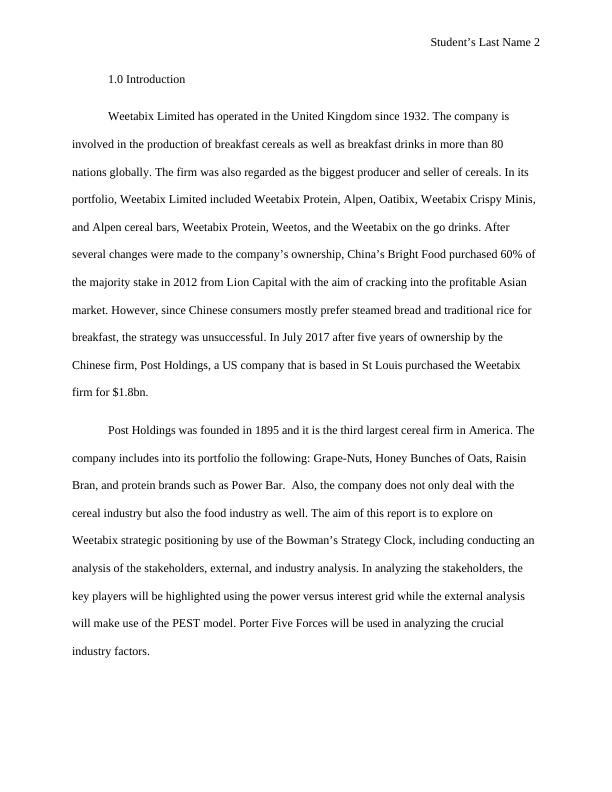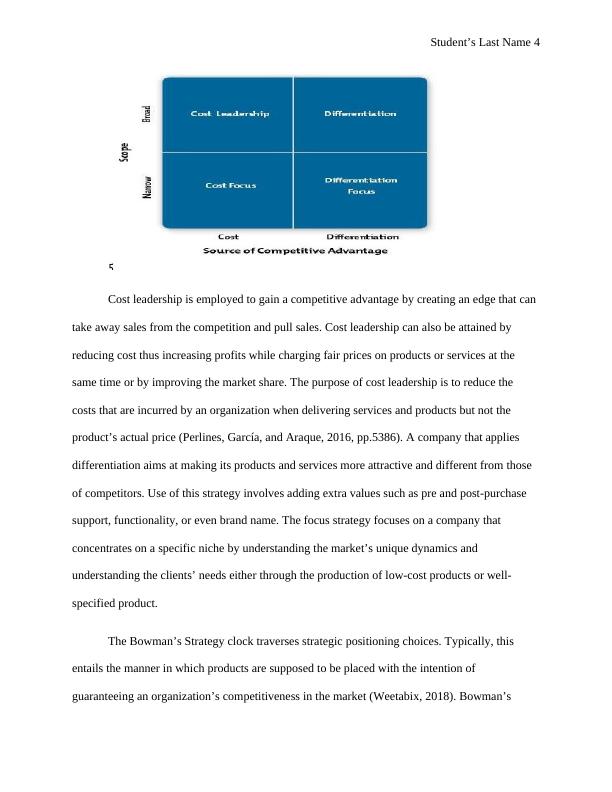Strategic Analysis: Tools and Techniques for Weetabix Limited
Added on 2023-06-07
17 Pages4639 Words102 Views
Student’s Last Name 1
Strategic Analysis: Tools and Techniques
By (Name)
Course
Professor
University
Date
Strategic Analysis: Tools and Techniques
By (Name)
Course
Professor
University
Date

Student’s Last Name 2
1.0 Introduction
Weetabix Limited has operated in the United Kingdom since 1932. The company is
involved in the production of breakfast cereals as well as breakfast drinks in more than 80
nations globally. The firm was also regarded as the biggest producer and seller of cereals. In its
portfolio, Weetabix Limited included Weetabix Protein, Alpen, Oatibix, Weetabix Crispy Minis,
and Alpen cereal bars, Weetabix Protein, Weetos, and the Weetabix on the go drinks. After
several changes were made to the company’s ownership, China’s Bright Food purchased 60% of
the majority stake in 2012 from Lion Capital with the aim of cracking into the profitable Asian
market. However, since Chinese consumers mostly prefer steamed bread and traditional rice for
breakfast, the strategy was unsuccessful. In July 2017 after five years of ownership by the
Chinese firm, Post Holdings, a US company that is based in St Louis purchased the Weetabix
firm for $1.8bn.
Post Holdings was founded in 1895 and it is the third largest cereal firm in America. The
company includes into its portfolio the following: Grape-Nuts, Honey Bunches of Oats, Raisin
Bran, and protein brands such as Power Bar. Also, the company does not only deal with the
cereal industry but also the food industry as well. The aim of this report is to explore on
Weetabix strategic positioning by use of the Bowman’s Strategy Clock, including conducting an
analysis of the stakeholders, external, and industry analysis. In analyzing the stakeholders, the
key players will be highlighted using the power versus interest grid while the external analysis
will make use of the PEST model. Porter Five Forces will be used in analyzing the crucial
industry factors.
1.0 Introduction
Weetabix Limited has operated in the United Kingdom since 1932. The company is
involved in the production of breakfast cereals as well as breakfast drinks in more than 80
nations globally. The firm was also regarded as the biggest producer and seller of cereals. In its
portfolio, Weetabix Limited included Weetabix Protein, Alpen, Oatibix, Weetabix Crispy Minis,
and Alpen cereal bars, Weetabix Protein, Weetos, and the Weetabix on the go drinks. After
several changes were made to the company’s ownership, China’s Bright Food purchased 60% of
the majority stake in 2012 from Lion Capital with the aim of cracking into the profitable Asian
market. However, since Chinese consumers mostly prefer steamed bread and traditional rice for
breakfast, the strategy was unsuccessful. In July 2017 after five years of ownership by the
Chinese firm, Post Holdings, a US company that is based in St Louis purchased the Weetabix
firm for $1.8bn.
Post Holdings was founded in 1895 and it is the third largest cereal firm in America. The
company includes into its portfolio the following: Grape-Nuts, Honey Bunches of Oats, Raisin
Bran, and protein brands such as Power Bar. Also, the company does not only deal with the
cereal industry but also the food industry as well. The aim of this report is to explore on
Weetabix strategic positioning by use of the Bowman’s Strategy Clock, including conducting an
analysis of the stakeholders, external, and industry analysis. In analyzing the stakeholders, the
key players will be highlighted using the power versus interest grid while the external analysis
will make use of the PEST model. Porter Five Forces will be used in analyzing the crucial
industry factors.

Student’s Last Name 3
2.0 Strategic Positioning
Strategic positioning involves a firm’s choice regarding the value that they add to their
products to ensure that they are different from their rivals (Nowicka, 2013, pp.31). There are
different levels of strategy which include the Strategic Business Units and the Business Level
Strategy that help an individual business to remain competitive within a given market.
Additionally, the Bowman’s Clock can be used to identify a company’s positioning by
identifying strategic zones and how to analyze the rival’s competitive position (Wason and
Charlton, 2015, pp.111). As a result, an organization may raise its prices through differentiation
or through cost leadership. Differentiation refers to delivering distinctive value to the clients
while cost leadership entails balancing acceptable quality with prices with the intention of
competing on cost with competitors.
Strategic positioning takes into account the SBU’s position in the future but at the same
time considering the constantly evolving environment as well as the methodologies that are
necessary for achieving that position (Brenes, Montoya and Ciravegna, 2014, pp.853). Strategic
positioning is essential because it helps an organization in selecting a peculiar niche. This is a
reflection of a firm’s choice regarding the value it aims to create and the manner which differs
from its competitors.
Porters Five Forces and the Bowman’s Strategy Clock are some of the strategic
frameworks that can be adopted easily if an organization is to gain an advantage over its
competitors (Rashidirad, Soltani and Syed, 2013, pp.218). Three generic strategies can be used
by an organization. Michael Porter (2015) identifies these strategies which include focus, cost
leadership, and differentiation.
2.0 Strategic Positioning
Strategic positioning involves a firm’s choice regarding the value that they add to their
products to ensure that they are different from their rivals (Nowicka, 2013, pp.31). There are
different levels of strategy which include the Strategic Business Units and the Business Level
Strategy that help an individual business to remain competitive within a given market.
Additionally, the Bowman’s Clock can be used to identify a company’s positioning by
identifying strategic zones and how to analyze the rival’s competitive position (Wason and
Charlton, 2015, pp.111). As a result, an organization may raise its prices through differentiation
or through cost leadership. Differentiation refers to delivering distinctive value to the clients
while cost leadership entails balancing acceptable quality with prices with the intention of
competing on cost with competitors.
Strategic positioning takes into account the SBU’s position in the future but at the same
time considering the constantly evolving environment as well as the methodologies that are
necessary for achieving that position (Brenes, Montoya and Ciravegna, 2014, pp.853). Strategic
positioning is essential because it helps an organization in selecting a peculiar niche. This is a
reflection of a firm’s choice regarding the value it aims to create and the manner which differs
from its competitors.
Porters Five Forces and the Bowman’s Strategy Clock are some of the strategic
frameworks that can be adopted easily if an organization is to gain an advantage over its
competitors (Rashidirad, Soltani and Syed, 2013, pp.218). Three generic strategies can be used
by an organization. Michael Porter (2015) identifies these strategies which include focus, cost
leadership, and differentiation.

Student’s Last Name 4
Cost leadership is employed to gain a competitive advantage by creating an edge that can
take away sales from the competition and pull sales. Cost leadership can also be attained by
reducing cost thus increasing profits while charging fair prices on products or services at the
same time or by improving the market share. The purpose of cost leadership is to reduce the
costs that are incurred by an organization when delivering services and products but not the
product’s actual price (Perlines, García, and Araque, 2016, pp.5386). A company that applies
differentiation aims at making its products and services more attractive and different from those
of competitors. Use of this strategy involves adding extra values such as pre and post-purchase
support, functionality, or even brand name. The focus strategy focuses on a company that
concentrates on a specific niche by understanding the market’s unique dynamics and
understanding the clients’ needs either through the production of low-cost products or well-
specified product.
The Bowman’s Strategy clock traverses strategic positioning choices. Typically, this
entails the manner in which products are supposed to be placed with the intention of
guaranteeing an organization’s competitiveness in the market (Weetabix, 2018). Bowman’s
Cost leadership is employed to gain a competitive advantage by creating an edge that can
take away sales from the competition and pull sales. Cost leadership can also be attained by
reducing cost thus increasing profits while charging fair prices on products or services at the
same time or by improving the market share. The purpose of cost leadership is to reduce the
costs that are incurred by an organization when delivering services and products but not the
product’s actual price (Perlines, García, and Araque, 2016, pp.5386). A company that applies
differentiation aims at making its products and services more attractive and different from those
of competitors. Use of this strategy involves adding extra values such as pre and post-purchase
support, functionality, or even brand name. The focus strategy focuses on a company that
concentrates on a specific niche by understanding the market’s unique dynamics and
understanding the clients’ needs either through the production of low-cost products or well-
specified product.
The Bowman’s Strategy clock traverses strategic positioning choices. Typically, this
entails the manner in which products are supposed to be placed with the intention of
guaranteeing an organization’s competitiveness in the market (Weetabix, 2018). Bowman’s

End of preview
Want to access all the pages? Upload your documents or become a member.
Related Documents
Strategic Analysis: Tools and Techniqueslg...
|8
|714
|158
Strategic Analysis - Tools and Techniqueslg...
|19
|4090
|25
Strategic Management - Post Holdingslg...
|16
|3688
|25
